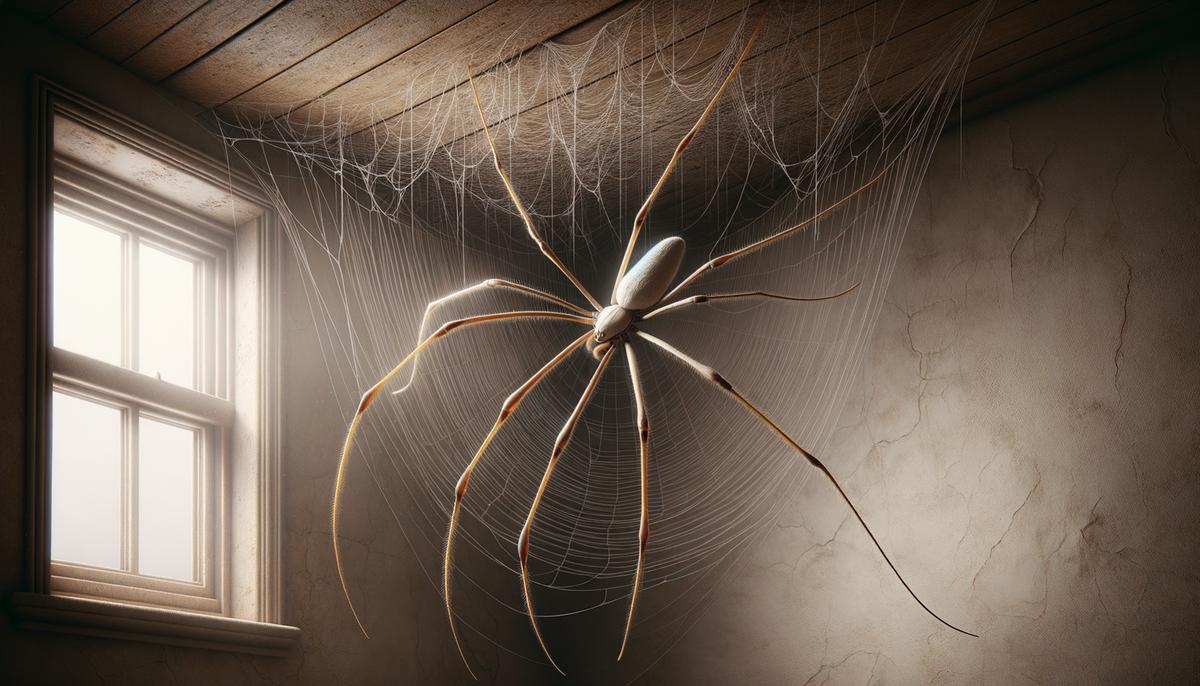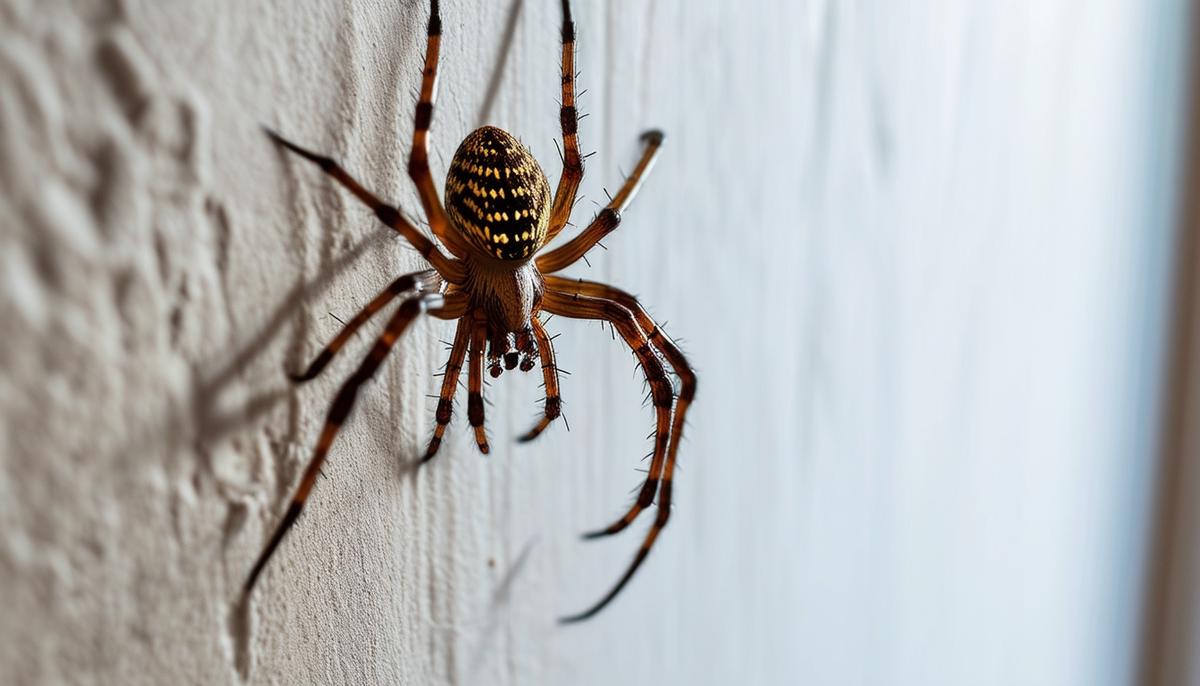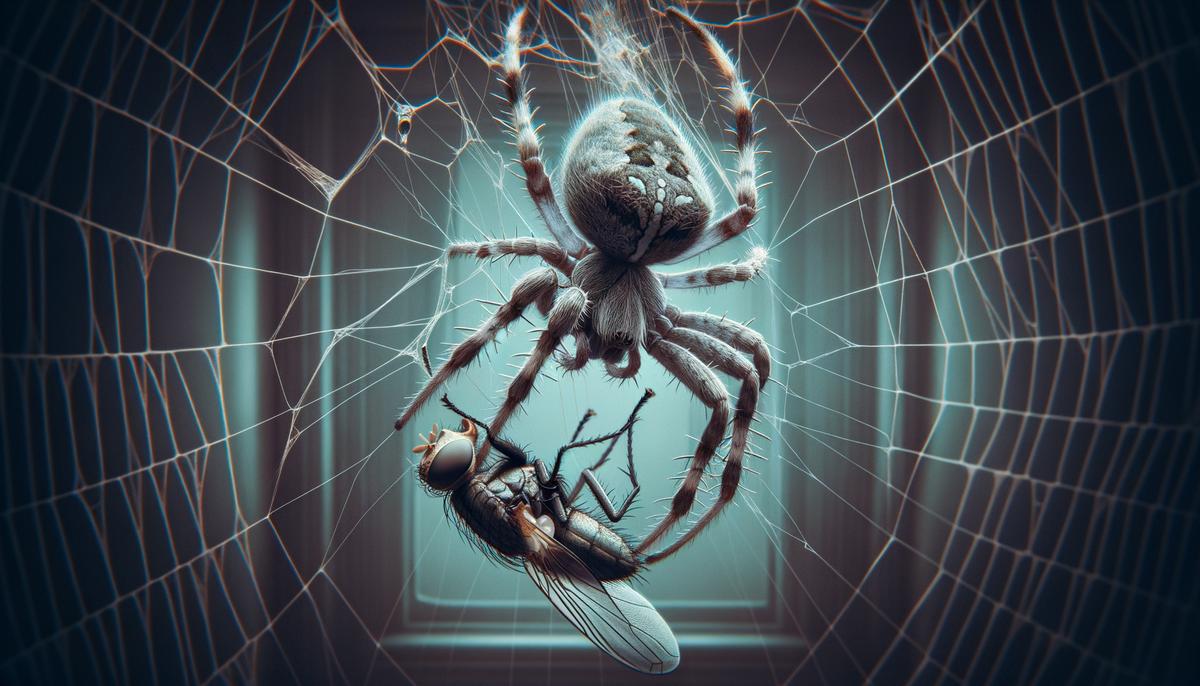Common Species
The Daddy-long-legs Spider, scientifically known as Pholcus phalangioides, is a frequent guest in London homes. Known for its long, thin legs and small body, this spider capitalizes on high corners and less-disturbed areas of our dwellings. An interesting behavior is its defence mechanism—when threatened, it vibrates rapidly in its web, becoming a blur to deter predators and possibly to amuse curious human onlookers.
The House Spider, or Tegenaria species, are among the more robust spiders you might encounter scuttling across your living room floor. Males are particularly noticeable during autumn as they roam in search of a mate. Appearance-wise, they boast a sizable brown cephalothorax and a similarly hued abdomen, often marked with a distinctive 'herringbone' pattern1. While their presence might startle, they're excellent at keeping pest populations down, spinning sheet-like webs usually out of sight in garages and sheds.
The Cellar Spider, often referred to as Daddy Long Legs, like its Pholcus phalangioides cousin, though they belong to different families. Notable for their exceptionally elongated legs and small bodies, Cellar Spiders are often found in the quieter nooks of a home, particularly in basements and attics. During daylight hours, don't be surprised to see them motionless, hanging upside down in their webs—a peculiar sight if ever there was one.
Each of these species varies slightly in habitat preference and appearance but shares a common role as unobtrusive co-inhabitants of our urban spaces. Their contributions extend beyond mere presence; by feeding on common household pests, they perform a welcome, if often unnoticed, form of natural pest control.

Habitats and Behaviors
In exploring the typical habitats within our London homes that spiders choose for residence, one observes a fascinating diversity dictated by species-specific preferences. For instance, the "Garage Guardian," otherwise known as the House Spider, prefers the undisturbed corners of garages and sheds, where their sheet-like webs tangled among tools and boxes form strategic trapping grounds for various insects. Their preference for such spots is primarily driven by a lower human interference and a steady supply of prey that frequent these lesser-visited enclosures.
Similarly, window frames and the meeting of walls and ceilings offer prime real estate for other types of spiders, notably the Lace Web Spider and the Buzzing Spider. These areas are not only out of the everyday reach of human activity but also perfect for catching the light and warmth that attract other insects – a spider's buffet.
Spiders such as the Zebra Spider, an active jumper known for its stark black and white markings, opt for a different tactic. As non-web builders, they rely on their agility and speed to hunt down their prey rather than spinning webs. Their sudden, precise leaps often catch unsuspecting prey completely off-guard, an almost thrilling spectacle if caught in action2. These Lycosidae, due to their ground-hunting nature, are more commonly found on the floors of homes, traversing between the terrain of carpets and hardwood floors, making split-second decisions to lunge at prey.
The lifecycle and building practice of orb-weaver spiders are equally efficient yet artistic. Gardens are the canvas, and the webs are intricate designs that not only serve as traps but also as shelter and breeding grounds3. Through a careful process of constructing radial threads connected by a spiral catching thread, they create large orb-like webs that are a testament to both artistry and engineering in the arachnid world.
In recognizing these different habitats and behaviors, it fosters an appreciation for the adaptive capabilities of spiders, enabling a coexistence that benefits both human and arachnid occupants. This intrinsic balance in our urban ecosystem, often unnoticed, reaffirms that every creature, regardless of size or habitat, plays an indispensable role in maintaining the ecological equilibrium of our shared urban landscapes.

Seasonal Activity Patterns
Autumn, particularly from late September to November, marks a noticeable uptick in spider activity within our homes. This is primarily due to the mating rituals of male spiders who venture out from their hidden retreats in search of potential mates. As the temperature outside begins to drop, these driven arachnids make their way indoors, motivated by the biological imperative to reproduce4. During this time, it's not uncommon to witness male spiders scuttling across floors or climbing walls, their presence more pronounced than at other times of the year.
The readiness of male house spiders to find a mate leads them into more visible areas of human habitation. Size plays a significant role here too; the larger the spider, such as the mature Tegenaria species, the more likely they are to catch our eye. Their sometimes startling bursts of speed can startle the unexpecting homeowner, turning these poor wanderers into subjects of fear and fascination.
Weather changes also exert considerable influence on spider movements and visibility in our homes. Rainy periods, particularly during autumn and spring, flush spiders from their outside hideaways into buildings. Increased humidity inside houses can make indoor environments less desirable for spiders, but ongoing rain may leave them with fewer options for relocation. Conversely, during drier spells or in centrally heated homes during winter, spiders search for moisture. This can drive them into bathrooms or basements, where humidity levels are relatively higher5. Thus, the combination of breeding drives and fluctuating weather patterns effectively shapes the seasonal ebb and flow of spider populations within our domestic spaces.
Through understanding these patterns, homeowners can better manage their expectations and reactions to these seasonal guests. While their increased autumnal visibility might unsettle some, remembering their role in controlling pests such as flies and mosquitoes might foster a more appreciative view of these natural hunters. After all, these creatures are fulfilling their part in the ecological tapestry while inadvertently assisting in household pest management, aligning with our desires for comfortable, insect-free living spaces.

Human-Spider Interactions
Despite the chill that runs down many a spine at the sight of a spider skittling across the living room floor, interactions between humans and these arachnids are usually uneventful and mostly based on misunderstanding. The common narration around these creatures involves fear-packed myths that lend to their undeserved infamy.
It's essential to address the pinnacle of spider-related fears: the bite. While it's true that all spiders possess the ability to bite, as that's their nature-driven methodology for capturing prey, this action is exceptionally rare amongst spiders inhabiting London homes. Contrary to the menacing portrait often painted, most house-friendly spiders have mouthparts too small or too weak to break human skin6. For example, the frequently encountered house spider. Despite its intimidating appearance and swift movements, its bites are rare and typically result in nothing more than a minor irritation, which cases remain exceedingly scarce.
The fear often associated with these creatures overshadows the substantial benefits they bring into our domestic spaces. Spiders are nature's pest controllers. By feasting on a variety of household pests, including flies, moths, mosquitoes, and even other spiders, they help reduce not just the nuisance but also the spread of diseases these pests could potentially carry. Without spiders' appetites, our homes could see surges in the populations of more problematic critters.
Many people believe that spiders come indoors to escape cold or wet conditions outside. However, as mentioned earlier, this influx—particularly noticed during the autumn—is largely due to the mating behavior of male spiders seeking partners. Once mating is completed, most of these nomadic suitors perish, concluding their most visible incursion into human habitats.
In the rare instance someone in the UK experiences a bite from a spider, the effects are typically minimal. On occasion, sensitivity to a bite may cause slight swelling or itching, but serious reactions are extraordinary7. The narrative that all spiders present serious health risks is misleading and adds unjustly to their objection.
By gently setting aside our fears and approaching our eight-legged cohabitants with curiosity and respect, we facilitate a healthier coexistence and engage more positively with our broader urban ecosystem. Understanding and appreciating spiders as an integral part of our domestic landscape enable us to foster environments where all creatures, irrespective of size, can thrive symbiotically. Thus, dispelling fears with facts demystifies spider interactions and potentially transforms cohabitation into a beneficial partnership. It is through such balanced views that the webs of misunderstanding can be thoroughly cleaned away.

In conclusion, while spiders may trigger unease with their sudden appearances in our homes, recognizing their role as natural pest controllers can shift perceptions from fear to appreciation. By fostering an understanding of these creatures' beneficial impacts, we not only enhance our coexistence but also support the health of our shared urban environment.
- Roberts MJ. Collins Field Guide: Spiders of Britain & Northern Europe. Harper Collins; 2001.
- Foelix R. Biology of Spiders. Oxford University Press; 2010.
- Brunetta L, Craig CL. Spider Silk: Evolution and 400 Million Years of Spinning, Waiting, Snagging, and Mating. Yale University Press; 2010.
- Uhl G, Nessler SH, Schneider JM. Securing paternity in spiders? A review on occurrence and effects of mating plugs and male genital mutilation. Genetica. 2010;138(1):75-104.
- Watson L, Dallwitz MJ. The Families of Spiders Represented in the British Isles. Delta-intkey.com. 2003.
- Stuber M, Nentwig W. How informative are case studies of spider bites in the medical literature? Toxicon. 2016;114:40-44.
- Warrell DA. Treatment of bites by adders and exotic venomous snakes. BMJ. 2005;331(7527):1244-1247.
Leave a Reply